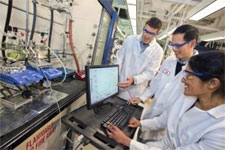Berkeley Scientists discover inexpensive metal catalyst for generating hydrogen from water
05 May 2010
Hydrogen would command a key role in future renewable energy technologies, experts agree, if a relatively cheap, efficient and carbon-neutral means of producing it can be developed. An important step towards this elusive goal has been taken by a team of researchers with the U.S. Department of Energy's (DOE) Lawrence Berkeley National Laboratory (Berkeley Lab) and the University of California, Berkeley. The team has discovered an inexpensive metal catalyst that can effectively generate hydrogen gas from water.
 |
| From left, Jeffrey Long, Christopher Chang and Hemamala Karunadasa have discovered an inexpensive metal that can generate hydrogen from neutral water, even if it is dirty, and can operate in sea water. (Photo by Roy Kaltschmidt, Berkeley Lab Public Affairs) |
Karunadasa holds joint appointments with Berkeley Lab's Chemical Sciences Division and UC Berkeley's Chemistry Department. She is the lead author of a paper describing this work that appears in the April 29, 2010 issue of the journal Nature, titled ''A molecular molybdenum-oxo catalyst for generating hydrogen from water.'' Co-authors of this paper were Christopher Chang and Jeffrey Long, who also hold joint appointments with Berkeley Lab and UC Berkeley. Chang, in addition, is also an investigator with the Howard Hughes Medical Institute (HHMI).
Hydrogen gas, whether combusted or used in fuel cells to generate electricity, emits only water vapor as an exhaust product, which is why this nation would already be rolling towards a hydrogen economy if only there were hydrogen wells to tap. However, hydrogen gas does not occur naturally and has to be produced. Most of the hydrogen gas in the United States today comes from natural gas, a fossil fuel. While inexpensive, this technique adds huge volumes of carbon emissions to the atmosphere. Hydrogen can also be produced through the electrolysis of water – using electricity to split molecules of water into molecules of hydrogen and oxygen. This is an environmentally clean and sustainable method of production – especially if the electricity is generated via a renewable technology such as solar or wind – but requires a water-splitting catalyst.
Nature has developed extremely efficient water-splitting enzymes – called hydrogenases – for use by plants during photosynthesis, however, these enzymes are highly unstable and easily deactivated when removed from their native environment. Human activities demand a stable metal catalyst that can operate under non-biological settings.
Metal catalysts are commercially available, but they are low valence precious metals whose high costs make their widespread use prohibitive. For example, platinum, the best of them, costs some $2,000 an ounce.













.jpg)






.jpg)









